| "You're moving the water around, but you're not feeling the push and pull." |
| — Pakku to Aang.[1] |
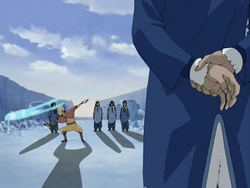
Master Pakku taught waterbending in the Northern Water Tribe.
Masters of waterbending employ a variety of distinct training exercises that considerably aid their pupils in mastering the art. The techniques used are directly influenced by each individual master's own upbringing and specific style of bending.
Moreover, bending training differs from one location to the next, as masters from the polar Water Tribes tend to focus more on benefiting from an advantageous environment,[1] while those situated elsewhere emphasize resourcefulness and use of water from non-conventional sources.[2]
Essential concepts
Versatility
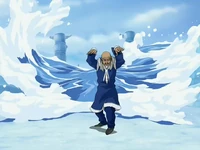
Water is the element of change, and as such, many waterbending masters will stress the versatility of water during training. The mark of a true master is their ability to effectively use water interchangeably in different phases with relative ease.
In Master Pakku's duel with Katara, he demonstrated that success in waterbending is as much about versatility as it is about strength. During the battle, Pakku subverted Katara's attacks to his own benefit, transforming her water strikes into solid ice and re-purposing them to launch his own attacks.[1]
After mastering the art during her visit to the Northern Water Tribe, Katara began to demonstrate the concept of versatility as well. In her duel against Mai and Ty Lee, she quickly utilized water whips before pulling them back in to create ice walls that shielded her from Mai's stilettos. Later on, Katara used the concept when training Aang, demonstrating versatility and phase change through her exercises.[3]
Resourcefulness
Prominence in the art of waterbending requires the efficient use of water, even in situations in which it is limited. When separated from the poles, where such benders can use the surrounding seas and glaciers to their advantage, master waterbenders need to hone their abilities so that they can adapt to any given environment.
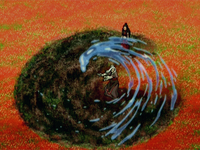
Hama exhibited resourcefulness when she extracted water out of a bed of fire lilies.
A prime example of such a specialized waterbender is Hama, who had acclimated herself to the conditions of the Fire Nation by using water from atypical sources. Establishing herself to be quite adept, Hama took advantage of the Fire Nation's humid environment to pull moisture out of the air, using the coalesced products during battle.[2]
In addition, Hama took advantage of plant life, utilizing water stored within them in her waterbending. Huu, a waterbender from the Foggy Swamp Tribe, also used a similar technique, wherein he manipulated plant life by taking hold of the water within them.[4] His technique was different from Hama's in the sense that his use of water did not necessarily harm the plant, whereas her use caused the plants to wither and die.[2]
Push and pull
Albeit a straightforward concept, the push and pull needed to waterbend is stressed by all waterbending masters. As the art was developed by mimicking how the moon moved the ocean, the same way in which tides push and pull the waves is how waterbending is most effectively performed.[5]
This is accentuated by Master Pakku, who stated to Aang while training him that manipulating water is not enough; one must feel the push and pull of water to succeed.[1]
Universal methods
Certain training techniques are used by most, if not all, waterbending masters. Most often, these are methods that involve the fundamentals of waterbending and employ only the most basic forms.
Streaming the water
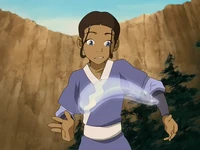
Named by Katara, streaming the water is a technique that involves drawing water from a physical source, before fluently shifting and moving it around the body. A far more advanced version was demonstrated by Aang, which involves sinking and floating for a far more successful performance.[6]
This technique forms the basis of waterbending, and is used in basic training to allow waterbenders to develop a "feel" for the water. It also serves as a warm-up exercise prior to a lesson, as demonstrated by Master Pakku, who used the technique while waiting for his pupils.[1]
Mastery of streaming can lead to far better control of water, as waterbenders can more effectively feel the movement and shifts of the water as they manipulate it. A demonstration by Pakku and two of his students during a tribal gathering used streaming as the main focus, wherein three large water globules were bent in unison, before being combined to create a massive water vesicle.[1]
Water duels
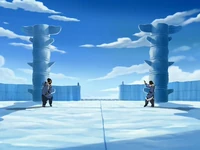
Katara and Sangok had a water duel in the Northern Water Tribe.
In most cases, water duels are executed by waterbending masters to test their students' proficiency in waterbending, and their pupils' ability to utilize waterbending effectively in combat. All training spars are fought until one combatant is immobilized or defeated, though the exact system in which battles are fought varies depending on the master.[5]
Master Pakku, having been the resident master of the North Pole, administered a large class, and as such, set up water duels wherein battles were fought successively, with the victor facing on against a number of opponents until he/she was defeated. This setup allowed Pakku to place students within different skill levels, and as such, gave him a reference as to who required more assistance.[5]
Katara, having only one student, sparred one-to-one with Aang, with the intention of testing his ability to capably battle with water, along with his proficiency in the use of certain techniques.[7] Moreover, considering Aang's innate ability and far greater skill being the Avatar, it was advantageous for him to spar with a waterbender of exceptional skill, as it was relatively more challenging and resembled situations he may face with particular adversaries.
In certain situations, Katara worked concurrently with Toph to train Aang in both waterbending and earthbending, by testing his ability to battle with two elements. In these instances, the two simultaneously dueled Aang, who was often subject to challenges such as being blindfolded, to force him into using seismic sense to perceive his environment.[8]
Individual methods
In most cases, each master will employ specific training methods during training, often associated with their own style of waterbending. Specialized forms are also set for water manipulation in idiosyncratic ways, some of which would not be commonly seen in other locations.
Katara
Katara served as Aang's waterbending mentor prior to and after being deemed a master herself. Eventually, she also became the mentor of the next Avatar, Korra, who she instructed in the art of waterbending. Due to having the majority of her training concentrated in the Northern Water Tribe,[5] Katara employed the Northern style of waterbending in combat, though likely included the Southern style after her tutelage under Hama.[2]
Fundamentals
To begin Aang's training in waterbending, Katara offered to instruct him in basic moves regarding the art. These included creating basic ripples in water through pushing and pulling, streaming small globules of water and creating basic waves.[6]
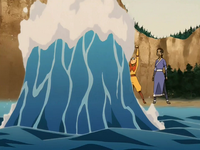
Aang created a big, powerful wave following Katara's unsuccessful demonstration.
Creating ripples in the water had the goal of developing a feel for the water, along with establishing a constant push and pull, both of which are key concepts involved in waterbending. As previously mentioned, streaming the water is a relatively basic form used to develop better control over water, along with familiarizing a pupil with how water feels as it is manipulated.[6]
Albeit not having mastered the move herself, Katara attempted to demonstrate the creation of a small wave to Aang. This exercise serves to develop a waterbender's ability to control large amounts of water, though no ability to manipulate the wave is involved, as the technique only deals with the creation. It is done by slowly creating a water column, before raising it up into the air.[6]
This form develops the foundation for other moves that require large fluid quantities, as evidenced when Katara used the technique to spawn a large wave during an attack against a Fire Navy ship.[9]
Octopus form
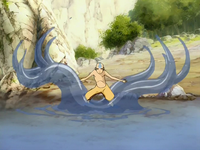
Aang used the octopus form during a training session.
The octopus form is a highly advanced waterbending move that involves pulling in a large water globule, before splitting it into eight sections that would expand into large tentacle-like extensions. The form is highly advantageous in battle, as it acts much like a shield that allows a waterbender to successfully attack and defend his or herself at the same time.[10]
Katara's exercise was to spar Aang, with him only utilizing the form as his primary means of offensive and defensive measures. This forced Aang to employ the technique, and develop a strong and protected center, important in all bending arts apart from his own.
While he was controlling the fluid octopus, Katara would attack Aang with ice spikes, to encourage him in controlling separate tentacles, along with combining several to form a water shield. An additional goal for Aang was to defeat Katara by utilizing the octopus form, which he did by using a tentacle to break her stance.[7]
Water vacillation
Water vacillation is a minor technique that acts more as an exercise than a lesson. In this, two waterbenders pass a globule of water to each other in a circular motion, stressing the importance of fluidity in waterbending. In addition, passing water brings forth an important strategy used by many waterbenders, which is the redirection of an opposing force as opposed to the creation of new force. Like many waterbending exercises, the technique also stresses the push and pull of water, along with the sinking and floating required to perform waterbending.[11]
Hama
As aforementioned, Hama had adapted to being situated in an environment where seas and bodies of water are scarcely present. As a result, much of her methods involved the use of water in unconventional ways. In addition, her training employed the Southern style of waterbending, as she originated from the Southern Water Tribe.[2]
Ambient water channeling
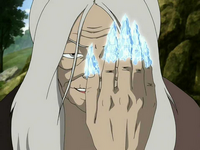
Hama was able to pull water out of the air.
The primary technique Hama stressed when training Katara was to keep an open mind and to remain resourceful in all situations. More specifically, she accentuated the presence of water in the atmosphere, and instructed Katara that moisture is accessible. Her exercises involved physically pulling ambient vapor and condensing it to liquid water, which she used to perform a variety of techniques, one of which involved creating ice claws.[2]
Hama also demonstrated that plants, such as fire lilies, are merely sources from which to bend from, and instructed Katara on how to remove moisture from flora for use in battle.[2]
Bloodbending
- Main article: Bloodbending
A darker art Hama decided to teach Katara was the art of bloodbending. This technique made use of all previous concepts Hama taught Katara, including the fact that it is essential to keep an open-mind as to the location of water. Bloodbending involves reaching into a living being, by taking hold of the fluids circulating within and manipulating it to move the subject in question as desired. The complexity and sophistication required to effectively perform bloodbending means that it is performable only under a full moon, when a waterbender's abilities are peaked.[2]
Yakone
Despite having his bending stripped from him by Avatar Aang, Yakone was well versed in the art of waterbending, and remained the only known individual capable of performing bloodbending without the need of physical movement or a full moon. Yakone's teaching methods were both demanding and exhaustive, often held in seclusion to enable the practice of bloodbending.[12]
Psychic bloodbending
Yakone taught his sons the techniques of bloodbending in progression, taking them on frequent "hunting trips" to curb suspicion. At first, he took his sons out to develop the fundamentals during the full moon, so that the natural boost to their abilities would make the art easier to learn. He eventually taught his sons to bloodbend at any time, as well as subdue multiple targets at once. As a waterbending prodigy, Noatak soon mastered Yakone's psychic bloodbending, merely requiring focus to levitate a pack of wolves from the ground. As a final measure, Yakone forced his sons to bloodbend each other in order to develop a hold on humans.[12]
Other methods
Waterbending scroll
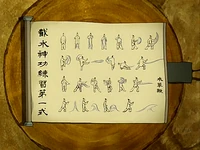
The waterbending scroll is a Northern Water Tribe relic.
- Main article: Waterbending scroll
The waterbending scroll is an ancient parchment that originated from the Northern Water Tribe. It contains visual representations to aid in mastery of basic waterbending forms, along with instructions on how to perform the single water whip and how to create small waves, among others.
It proved useful during the course of Team Avatar's journey, and aided Katara and Aang in the long run. For instance, the single water whip and variations of it were frequently utilized by Katara in battle.[6]